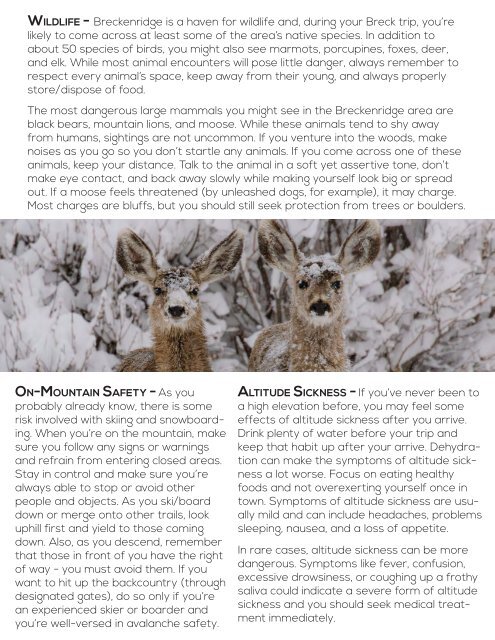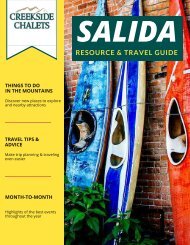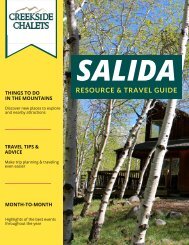Breckenridge Winter Travel Guide
Start planning your 2016-17 Breckenridge ski trip with our Winter Travel Guide.
Start planning your 2016-17 Breckenridge ski trip with our Winter Travel Guide.
You also want an ePaper? Increase the reach of your titles
YUMPU automatically turns print PDFs into web optimized ePapers that Google loves.
WILDLIFE - <strong>Breckenridge</strong> is a haven for wildlife and, during your Breck trip, you’re<br />
likely to come across at least some of the area’s native species. In addition to<br />
about 50 species of birds, you might also see marmots, porcupines, foxes, deer,<br />
and elk. While most animal encounters will pose little danger, always remember to<br />
respect every animal’s space, keep away from their young, and always properly<br />
store/dispose of food.<br />
The most dangerous large mammals you might see in the <strong>Breckenridge</strong> area are<br />
black bears, mountain lions, and moose. While these animals tend to shy away<br />
from humans, sightings are not uncommon. If you venture into the woods, make<br />
noises as you go so you don’t startle any animals. If you come across one of these<br />
animals, keep your distance. Talk to the animal in a soft yet assertive tone, don’t<br />
make eye contact, and back away slowly while making yourself look big or spread<br />
out. If a moose feels threatened (by unleashed dogs, for example), it may charge.<br />
Most charges are bluffs, but you should still seek protection from trees or boulders.<br />
ON-MOUNTAIN SAFETY - As you<br />
probably already know, there is some<br />
risk involved with skiing and snowboarding.<br />
When you’re on the mountain, make<br />
sure you follow any signs or warnings<br />
and refrain from entering closed areas.<br />
Stay in control and make sure you’re<br />
always able to stop or avoid other<br />
people and objects. As you ski/board<br />
down or merge onto other trails, look<br />
uphill first and yield to those coming<br />
down. Also, as you descend, remember<br />
that those in front of you have the right<br />
of way - you must avoid them. If you<br />
want to hit up the backcountry (through<br />
designated gates), do so only if you’re<br />
an experienced skier or boarder and<br />
you’re well-versed in avalanche safety.<br />
ALTITUDE SICKNESS - If you’ve never been to<br />
a high elevation before, you may feel some<br />
effects of altitude sickness after you arrive.<br />
Drink plenty of water before your trip and<br />
keep that habit up after your arrive. Dehydration<br />
can make the symptoms of altitude sickness<br />
a lot worse. Focus on eating healthy<br />
foods and not overexerting yourself once in<br />
town. Symptoms of altitude sickness are usually<br />
mild and can include headaches, problems<br />
sleeping, nausea, and a loss of appetite.<br />
In rare cases, altitude sickness can be more<br />
dangerous. Symptoms like fever, confusion,<br />
excessive drowsiness, or coughing up a frothy<br />
saliva could indicate a severe form of altitude<br />
sickness and you should seek medical treatment<br />
immediately.











